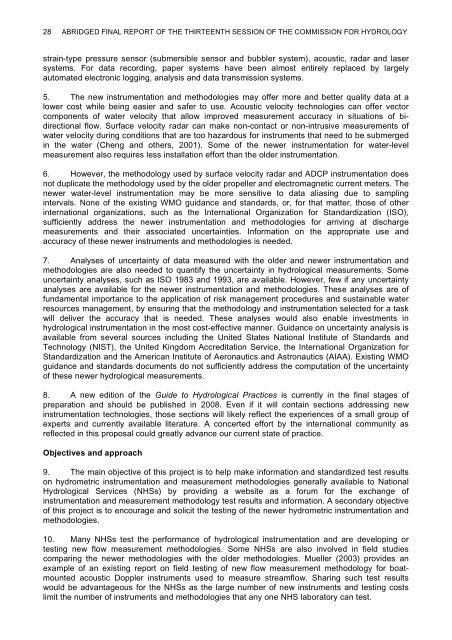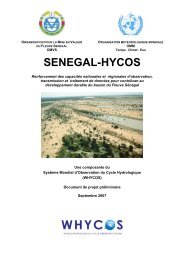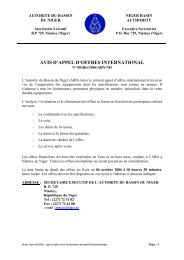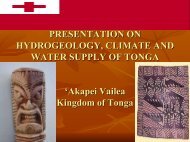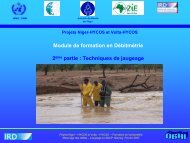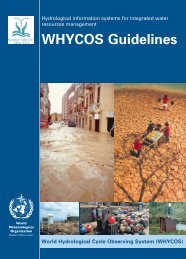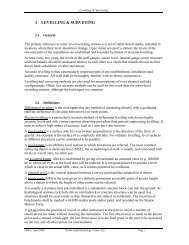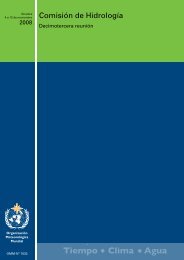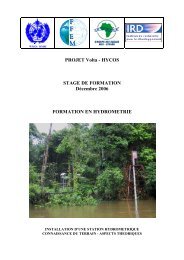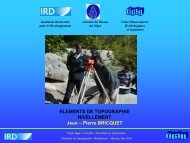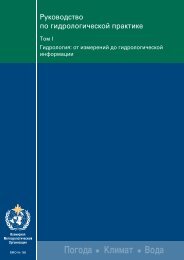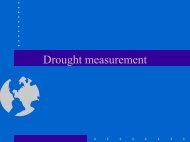Part I - FTP Directory Listing - WMO
Part I - FTP Directory Listing - WMO
Part I - FTP Directory Listing - WMO
Create successful ePaper yourself
Turn your PDF publications into a flip-book with our unique Google optimized e-Paper software.
28 ABRIDGED FINAL REPORT OF THE THIRTEENTH SESSION OF THE COMMISSION FOR HYDROLOGYstrain-type pressure sensor (submersible sensor and bubbler system), acoustic, radar and lasersystems. For data recording, paper systems have been almost entirely replaced by largelyautomated electronic logging, analysis and data transmission systems.5. The new instrumentation and methodologies may offer more and better quality data at alower cost while being easier and safer to use. Acoustic velocity technologies can offer vectorcomponents of water velocity that allow improved measurement accuracy in situations of bidirectionalflow. Surface velocity radar can make non-contact or non-intrusive measurements ofwater velocity during conditions that are too hazardous for instruments that need to be submergedin the water (Cheng and others, 2001). Some of the newer instrumentation for water-levelmeasurement also requires less installation effort than the older instrumentation.6. However, the methodology used by surface velocity radar and ADCP instrumentation doesnot duplicate the methodology used by the older propeller and electromagnetic current meters. Thenewer water-level instrumentation may be more sensitive to data aliasing due to samplingintervals. None of the existing <strong>WMO</strong> guidance and standards, or, for that matter, those of otherinternational organizations, such as the International Organization for Standardization (ISO),sufficiently address the newer instrumentation and methodologies for arriving at dischargemeasurements and their associated uncertainties. Information on the appropriate use andaccuracy of these newer instruments and methodologies is needed.7. Analyses of uncertainty of data measured with the older and newer instrumentation andmethodologies are also needed to quantify the uncertainty in hydrological measurements. Someuncertainty analyses, such as ISO 1983 and 1993, are available. However, few if any uncertaintyanalyses are available for the newer instrumentation and methodologies. These analyses are offundamental importance to the application of risk management procedures and sustainable waterresources management, by ensuring that the methodology and instrumentation selected for a taskwill deliver the accuracy that is needed. These analyses would also enable investments inhydrological instrumentation in the most cost-effective manner. Guidance on uncertainty analysis isavailable from several sources including the United States National Institute of Standards andTechnology (NIST), the United Kingdom Accreditation Service, the International Organization forStandardization and the American Institute of Aeronautics and Astronautics (AIAA). Existing <strong>WMO</strong>guidance and standards documents do not sufficiently address the computation of the uncertaintyof these newer hydrological measurements.8. A new edition of the Guide to Hydrological Practices is currently in the final stages ofpreparation and should be published in 2008. Even if it will contain sections addressing newinstrumentation technologies, those sections will likely reflect the experiences of a small group ofexperts and currently available literature. A concerted effort by the international community asreflected in this proposal could greatly advance our current state of practice.Objectives and approach9. The main objective of this project is to help make information and standardized test resultson hydrometric instrumentation and measurement methodologies generally available to NationalHydrological Services (NHSs) by providing a website as a forum for the exchange ofinstrumentation and measurement methodology test results and information. A secondary objectiveof this project is to encourage and solicit the testing of the newer hydrometric instrumentation andmethodologies.10. Many NHSs test the performance of hydrological instrumentation and are developing ortesting new flow measurement methodologies. Some NHSs are also involved in field studiescomparing the newer methodologies with the older methodologies. Mueller (2003) provides anexample of an existing report on field testing of new flow measurement methodology for boatmountedacoustic Doppler instruments used to measure streamflow. Sharing such test resultswould be advantageous for the NHSs as the large number of new instruments and testing costslimit the number of instruments and methodologies that any one NHS laboratory can test.


